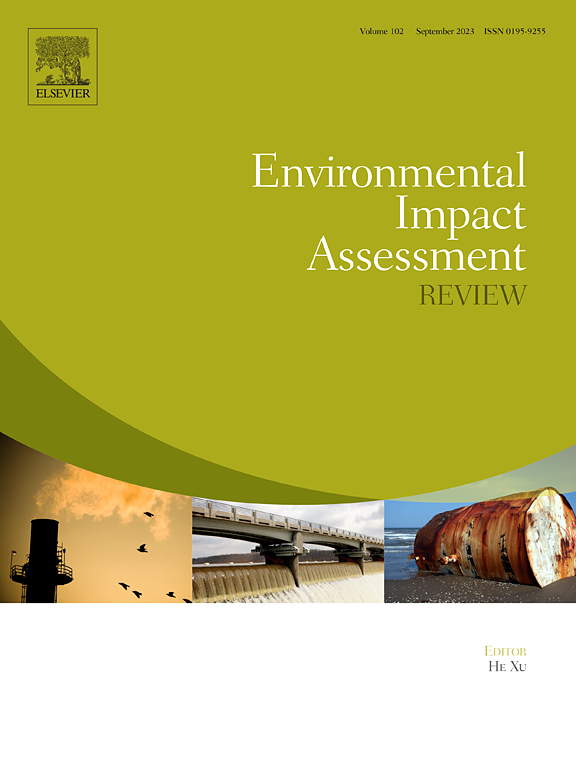Imperfect detection of terrestrial mammals in environmental impact assessment (EIA) baseline surveys may compromise decision-making and mitigation measures
IF 9.8
1区 社会学
Q1 ENVIRONMENTAL STUDIES
引用次数: 0
Abstract
The Environmental Impact Assessment (EIA) is critical for managing human impacts on biodiversity. Reliable baseline data is essential to assess potential development effects, while inaccurate information about species presence or absence can lead to poor decisions. We examined how methodological choices, such as sampling methods (i.e., camera traps, census, indirect sign surveys, interviews with locals), affect species detection in baseline biodiversity surveys for EIA in mining projects and scientific inventories, focusing on the Iron Quadrangle region of Minas Gerais, Brazil. We employed occupancy models, which consider imperfect detections, to assess how study type and methodological attributes influence false-positive and true detections of medium to large-sized terrestrial mammals. Our analysis revealed that study type strongly predicted false positives, with a potential additive effect with sampling method. In EIA baseline surveys, sign surveys registered 2.1 % false positives, rising to 4.4 % for interviews, while scientific studies had nearly zero false positives. For true detections, we found an interaction between study type and sampling method, where species census, camera traps, and sign surveys were up to three times less likely to detect species in EIA surveys compared to scientific studies. This suggests that EIA characteristics may reduce correct species detection. Both false-positive and true detections may be influenced by the inadequate quality of EIA baseline surveys. This underscores the need to incorporate detection estimates into biodiversity surveys. If studies fail to account for detection probability they can lead to biased and misleading results, which in the case of baseline surveys, could result in unfounded decisions within the EIA process.
在环境影响评估(EIA)基线调查中,陆生哺乳动物的检测不完善可能会影响决策和缓解措施
环境影响评价是管理人类对生物多样性影响的关键。可靠的基线数据对于评估潜在的发展影响至关重要,而关于物种存在或不存在的不准确信息可能导致错误的决定。我们研究了方法选择,如抽样方法(即相机陷阱、人口普查、间接标志调查、与当地人访谈)如何影响采矿项目和科学清单中基线生物多样性调查中的物种检测,重点是巴西米纳斯吉拉斯州的铁四边形地区。我们采用了考虑不完全检测的占用模型来评估研究类型和方法属性如何影响中大型陆生哺乳动物的假阳性和真检测。我们的分析显示,研究类型强烈预测假阳性,与抽样方法潜在的加性效应。在EIA基线调查中,标识调查的误报率为2.1%,访谈的误报率上升至4.4%,而科学研究的误报率几乎为零。对于真正的检测,我们发现研究类型和采样方法之间存在相互作用,其中物种普查,相机陷阱和标志调查在EIA调查中发现物种的可能性比科学研究低三倍。这表明,EIA特征可能会降低正确的物种检测。假阳性和真检测都可能受到环境影响评估基线调查质量不足的影响。这强调了将检测估计纳入生物多样性调查的必要性。如果研究未能考虑到检测概率,它们可能导致有偏见和误导性的结果,在基线调查的情况下,可能导致在环评过程中做出毫无根据的决定。
本文章由计算机程序翻译,如有差异,请以英文原文为准。
求助全文
约1分钟内获得全文
求助全文
来源期刊

Environmental Impact Assessment Review
ENVIRONMENTAL STUDIES-
CiteScore
12.60
自引率
10.10%
发文量
200
审稿时长
33 days
期刊介绍:
Environmental Impact Assessment Review is an interdisciplinary journal that serves a global audience of practitioners, policymakers, and academics involved in assessing the environmental impact of policies, projects, processes, and products. The journal focuses on innovative theory and practice in environmental impact assessment (EIA). Papers are expected to present innovative ideas, be topical, and coherent. The journal emphasizes concepts, methods, techniques, approaches, and systems related to EIA theory and practice.
 求助内容:
求助内容: 应助结果提醒方式:
应助结果提醒方式:


